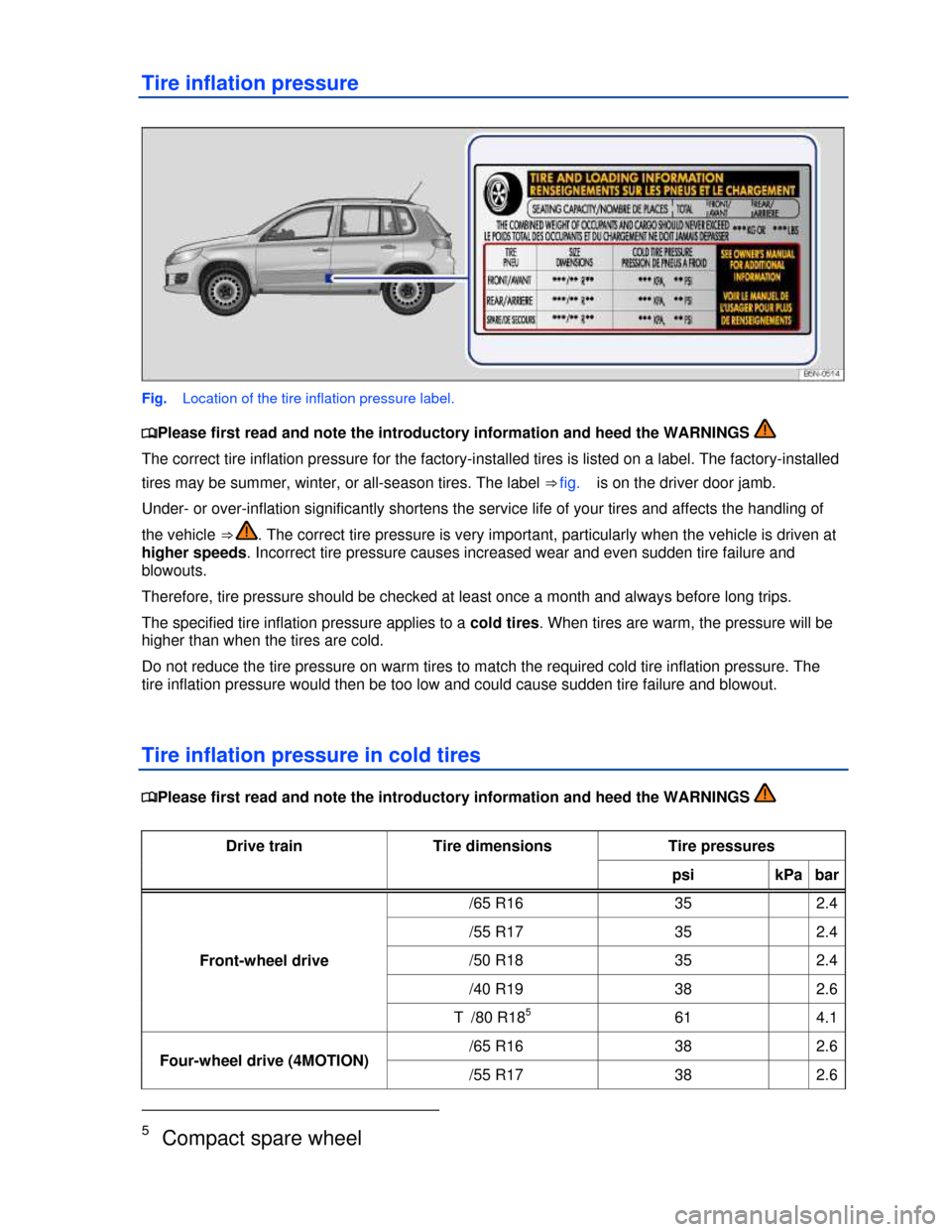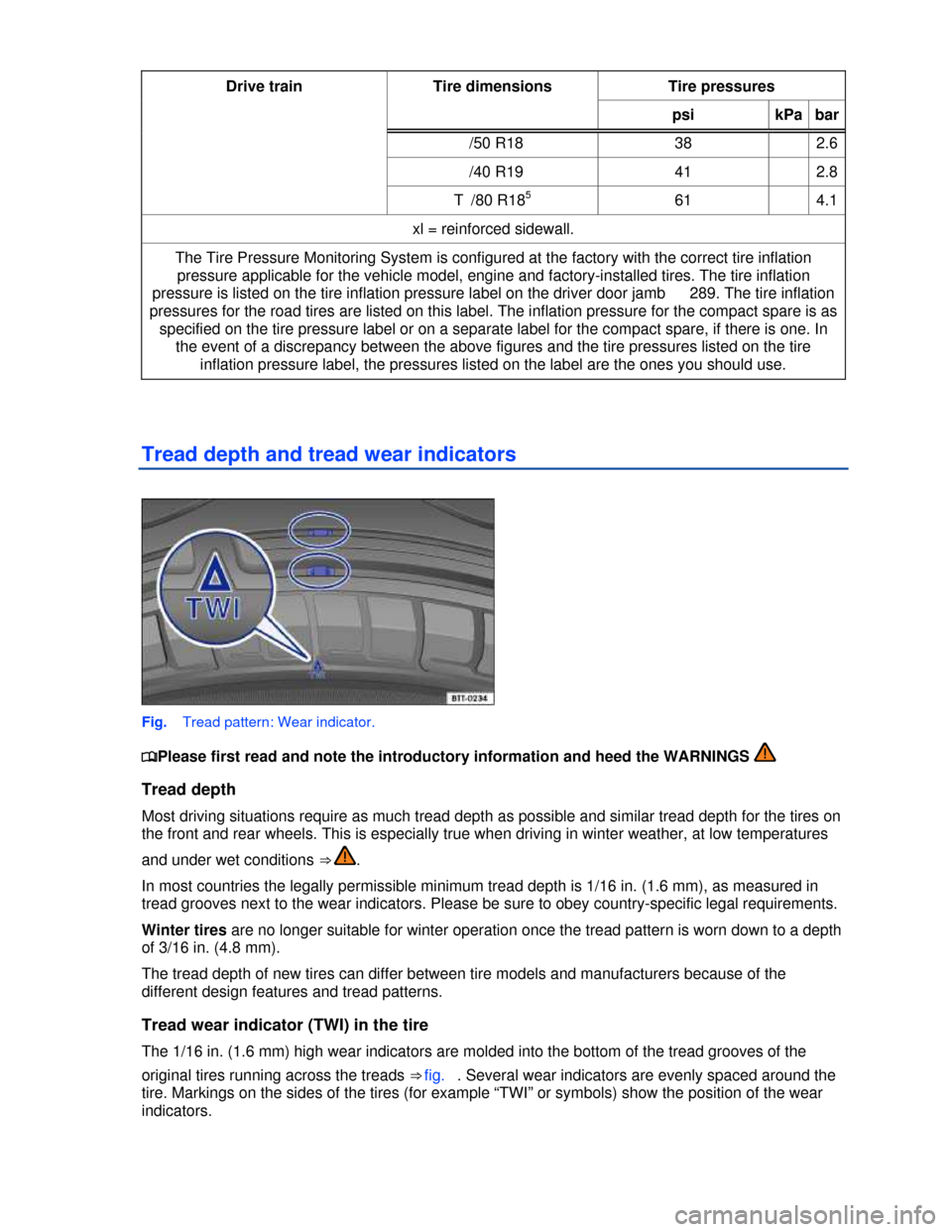2013 VOLKSWAGEN TIGUAN Tire pressure
[x] Cancel search: Tire pressurePage 229 of 356

NOTICE
Failure to heed warning lights or text WARNINGS can result in vehicle damage.
If the ignition is switched on, an acoustic warning sounds when low tire pressure is detected. If a
system malfunction is detected, no acoustic warning sounds.
Driving for a longer period of time on rough roads or with a dynamic and sporty style can make
the TPMS system temporarily unavailable. The indicator light will come on, signaling a malfunction, but
will go out again once road condition or driving style change.
Tire Pressure Monitoring System and recalibration with the MFI
�
Page 230 of 356

Your vehicle has also been equipped with a TPMS malfunction indicator to indicate when the system
is not operating properly. The TPMS malfunction indicator is combined with the low tire pressure
telltale. When the system detects a malfunction, the telltale will flash for approximately one minute and
then remain continuously illuminated. This sequence will continue upon subsequent vehicle start-ups
as long as the malfunction exists.
When the malfunction indicator is illuminated, the system may not be able to detect or signal low tire
pressure as intended. TPMS malfunctions may occur for a variety of reasons, including the installation
of replacement or alternate tires or wheels on the vehicle that prevent the TPMS from functioning
properly. Always check the TPMS malfunction telltale after replacing one or more tires or wheels on
your vehicle to ensure that the replacement or alternate tires and wheels allow the TPMS to continue
to function properly.
Resetting and recalibrating the benchmark tire pressure
Resetting the tire pressures in the Multi-function Indicator (MFI) resets the benchmark tire pressure
used by the TPMS to the current tire pressure in the tires based on the circumference of the tires.
To reset the reference tire pressure, switch on the ignition. In the MFI, navigate to the Settings menu
and select Tire pressure. Store and confirm the new tire pressures.
The re-calibration must be performed each time the tire pressure in one or more tires has been
adjusted or after one or more tires has been changed, exchanged, or repaired. The new tire pressures
are stored in the system only after at least 20 minutes of normal driving.
If you have reset the benchmark tire pressure when your tires do not have the correct tire pressure,
this will prevent the TPMS from working properly. It may then give false warnings or may not give any
warning even if the tire pressure is too low.
For this reason, it is vital to make certain that all four tires are inflated to the correct pressure
when they are cold, before calibrating the system. Cold tire tires are tires that have not been driven
more than a couple of miles (kilometers) at low speed within the last 3 hours.
Recalibrate the system to reset the benchmark TPMS pressure in the following
situations:
�x After installing tires on your vehicle that have recommended cold tire inflation pressures that are
different from the tires that were taken off.
�x After any tire on your vehicle is removed and then remounted, even if the same tire and wheel rim
that were taken off are reinstalled (for instance, after repair).
�x After any tire on your vehicle is changed and replaced by another tire, even if the replacement tire
is the same type and is inflated to the same pressure as the tire it replaced.
�x After adjusting the tire pressure of any tire on the vehicle to its correct cold tire inflation pressure,
either by putting air in one or more tires or by letting air out. Do this even though air was only added
(or let out) to bring the tire to the inflation pressure it should have had all along.
�x After rotating the front and rear wheels
�x After mounting the compact spare tire.
WARNING
Incorrect calibration can cause the TPMS to give false warnings or to give no warning despite
dangerously low tire pressures. Make certain the tire inflation pressure of all tires is correct
before calibrating the system.
Page 231 of 356

WARNING
Incorrect tire pressure can cause sudden tire failure, loss of vehicle control and serious
personal injury.
�x Always check and correct air pressure in all four tires, particularly after changing,
exchanging, or repairing tires.
�x After that, always make sure that all 4 tires are inflated to the correct tire pressure for the
tires installed on the vehicle. Then recalibrate the system so that it can properly monitor the
pressure in the tire.
�x See the tire pressure label and the Owner's Literature for recommended cold tire inflation
pressure and other important information.
�x When replacing tires or wheel rims, always read and heed all of the information and
WARNINGS
�x The Tire Pressure Monitoring System must be recalibrated using the MFI whenever you
remove and remount or change any wheel or tire on the vehicle, even if the reinstalled or
replacement wheels and tires are identical to those that were removed and even if the tire
pressure does not change.
The Tire Pressure Monitoring System stops working if there is an ESC/ABS malfunction.
After a low tire pressure warning, the vehicle must stand and must not be driven for at least one
minute before the new benchmark tire pressures can be stored.
Page 289 of 356

WARNING
New tires or tires that are old, worn or damaged cannot provide maximum control and
braking performance.
�x Improper care and handling of tires and wheels can reduce driving safety and cause
accidents and severe injuries.
�x Install only radial tires of the same make, the same dimensions (tread circumference), and
similar tread profile on all 4 wheels.
�x New tires tend to be slippery and must be broken in. Always drive with special care for the
first miles ( km) to help reduce the risk of losing control, a collision, and serious personal
injuries.
�x Check tire inflation pressure regularly when the tires are cold and always maintain the
prescribed tire pressure. Low tire pressure can cause tires to get too hot, resulting in tread
separation, sudden loss of pressure, and blowouts. Tires with excessively low pressure flex
(bend) more, which can cause the tire to overheat and fail suddenly without warning.
�x Check tires regularly for wear and damage.
�x Never drive with worn or damaged tires (for example, tires with punctures, cuts, cracks,
blisters, or bumps). Driving with worn or damaged tires can lead to loss of vehicle control,
sudden tire failure including blowouts and sudden deflation, crashes, and serious personal
injuries.
�x Have worn or damaged tires replaced immediately.
�x Never exceed the maximum speed rating or the maximum load rating of the tires on your
vehicle.
�x The effectiveness of the driver assistance systems and the braking support systems
depends on the tire traction.
�x If you notice unusual vibration or if the vehicle pulls to one side when driving, always stop
as soon as it is safe to do so and check the wheels and tires for damage.
�x To reduce the risk of losing control, crashes, and serious personal injuries, never loosen
the bolts on wheels with bolted rim rings.
�x Never mount used tires on your vehicle if you are not sure of their past use. Old, used
tires and wheels may have damage that cannot be seen that can lead to sudden tire failure
and loss of vehicle control.
�x Tires age even if they are not being used and can fail suddenly, especially at high speeds,
causing loss of vehicle control, accidents, and severe personal injuries. Tires that are more
than 6 years old can be used only in an emergency and even then only with special care and
at low speed.
For technical reasons it is usually not possible to use wheel rims from other vehicles. Even wheel
rims from the same model may not fit properly. Check with an authorized Volkswagen dealer or
authorized Volkswagen Service Facility if necessary.
Page 293 of 356

Tire inflation pressure
Fig. Location of the tire inflation pressure label.
�
Page 294 of 356

Drive train Tire dimensions Tire pressures
psi kPa bar
/50 R18 38 2.6
/40 R19 41 2.8
T /80 R185 61 4.1
xl = reinforced sidewall.
The Tire Pressure Monitoring System is configured at the factory with the correct tire inflation
pressure applicable for the vehicle model, engine and factory-installed tires. The tire inflation
pressure is listed on the tire inflation pressure label on the driver door jamb 289. The tire inflation
pressures for the road tires are listed on this label. The inflation pressure for the compact spare is as
specified on the tire pressure label or on a separate label for the compact spare, if there is one. In
the event of a discrepancy between the above figures and the tire pressures listed on the tire
inflation pressure label, the pressures listed on the label are the ones you should use.
Tread depth and tread wear indicators
Fig. Tread pattern: Wear indicator.
�
Page 297 of 356

Stowing the replaced wheel
One of the vehicles normal wheels will not fit in the well for the compact spare wheel in the floor of the
luggage compartment. Therefore, in the event of a flat tire, the wheel which was changed must be
secured, for example, with suitable straps in the luggage compartment.
Open the rear hatch, raise the entire luggage compartment floor, press the retaining pin (1) to the right
and slowly lower the luggage compartment floor.
Put the wheel you took off the vehicle into the spare wheel well so that the center hole of the rim is
aligned with the threaded pin.
Turn the threaded retainer in the center of the compact spare wheel (2) clockwise until the wheel
replaced is securely in place.
If necessary, return the vehicle tool kit to its location in the luggage compartment.
Raise the floor covering and release the retaining pin, then fold the floor covering back down onto the
floor of the luggage compartment.
Close the rear hatch.
Differences between the road tires and the compact spare
The compact spare is different in design from the road tires and must be used only in the event of a
flat tire, only for a brief time, and only when driving with extra caution ⇒ .
Replace it with a tire matching the others on your vehicle as soon as possible.
Please heed the following:
�x Do not drive faster than 50 mph (80 km/h)!
�x Avoid full-throttle acceleration, hard braking and fast cornering!
�x Do not use snow chains on the compact spare wheel
�x After installing the compact spare tire, check the tire pressure as soon as possible
Check the tire inflation pressure of the compact spare whenever you check the tire pressure of the
road wheels, at least once a month. Inflate a compact spare tire to the cold tire pressure specified for
the compact spare on the tire pressure label or on a separate label for the compact spare, if there is
one.
Page 298 of 356

WARNING
Improper use of a compact spare tire can cause loss of vehicle control, a crash or other
accident, and serious personal injury.
�x Never use a compact spare tire if it is damaged or worn down to the wear indicators.
�x In some vehicles, the compact spare tire is smaller than the original tire. A smaller
compact spare tire is identified with a sticker and the words “50 mph” or “80 km/h”. This is
the maximum permissible speed when driving with this tire.
�x Never drive faster than 50 mph (80 km/h) with a compact spare tire. Avoid full-throttle
acceleration, heavy braking, and fast cornering!
�x Never drive more than miles ( km) if a compact spare wheel is installed on the front axle
(drive axle).
�x Replace the compact spare with a normal wheel and tire as soon as possible. Compact
spare tires are designed for brief use only.
�x Regularly check the U.S. DOT Tire Identification Number (TIN) to determine the age of the
compact spare tire
�x Tires age even if they are not being used and can fail suddenly, especially at higher
speeds.
�x Tires that are more than 6 years old can only be used in an emergency and then with
special care and at low speeds.
�x The compact spare tire must always be secured with the wheel bolts provided by the
factory.
�x Never drive using more than one compact spare wheel.
�x After installing the compact spare tire, the tire pressure must be checked as soon as
possible
�x Snow chains cannot be used on the compact wheel tire. If you must use snow chains and
have a compact spare wheel mounted, move the compact spare tire to the rear axle if a front
tire has to be replaced. The tire taken off the rear axle can then be used to replace the flat
front tire. Be sure you do not change the tire's direction of rotation. Install the snow chains
on the full-sized road tire.
NOTICE
When the spare wheel or compact spare is being used, the TPMS indicator light can start
flashing after about 10 minutes.
If possible, attach the compact spare tire or the tire you took off the vehicle securely in the
luggage compartment.